Variation in SCM Supply Effects as Reflected by Coupling Relationship with Pycnocline
Abstract
Highlights
- By establishing a linear regression equation between the pycnocline and the subsurface chlorophyll maximum (SCM), the monthly coupling coefficient was calculated, revealing a cyclical pattern of strengthening and weakening in their coupling relationship.
- During periods of strong coupling, the chlorophyll profile peak consistently coincides with the particulate backscattering (BBP) profile peak, a phenomenon that has been validated through BGC-Argo observations.
- The formation mechanisms of the SCM are not static in the corresponding regions but exhibit cyclical patterns on seasonal scales.
- The pycnocline influences biomass accumulation by either enhancing (through efficient nutrient mixing within the pycnocline) or suppressing (by restricting nutrient exchange across the pycnocline) nutrient availability via its mixing and stratification effects. This mechanism drives the cyclical patterns observed in the formation of the SCM.
Abstract
1. Introduction
2. Materials and Methods
2.1. SCM Datasets
2.2. Pycnocline Datasets
2.3. ZEU Datasets
2.4. Data Processing
2.4.1. SCM Processing
2.4.2. Pycnocline and MLD Processing
2.4.3. BGC-Argo Processing
3. Results
3.1. Global Distribution of the Pycnocline and SCM
3.2. The Coupling Result of 1° Grid Matching SCM and Density Layering
3.3. Seasonal Coupling Relationship
3.3.1. Indian Ocean Region
3.3.2. Northwest Pacific Region
3.3.3. Southeast Pacific Region
3.3.4. South Atlantic Region
4. Discussion
5. Conclusions
- (1)
- The relative importance of the factors governing the formation and maintenance of the SCM on a seasonal scale is not static but is seasonally dependent.
- (2)
- Phytoplankton aggregation consistently plays a significant role in the seasonal cyclical variations in the SCM across various marine regions.
- (3)
- The pycnocline influences the distribution of nutrients and the activity of phytoplankton in the ocean through cyclical seasonal variations, thereby affecting the formation and maintenance of the SCM and leading to periodic fluctuations in the strength of their coupling.
Author Contributions
Funding
Data Availability Statement
Conflicts of Interest
References
- Cowles, T.J. Planktonic layers: Physical and biological interactions on the small scale. In Handbook of ScalingMethods in Aquatic Ecology: Measurement, Analysis, Simulation; Seuront, L., Strutton, P.G., Eds.; CRC Press: Boca Raton, FL, USA, 2003; pp. 31–49. [Google Scholar]
- Lévy, M. The Modulation of Biological Production by Oceanic Mesoscale Turbulence. In Transport and Mixing in Geophysical Flows; Weiss, J.B., Provenzale, A., Eds.; Lecture Notes in Physics; Springer: Berlin/Heidelberg, Germany, 2008; p. 744. [Google Scholar]
- Cornec, M.; Claustre, H.; Mignot, A.; Guidi, L.; Lacour, L.; Poteau, A.; D’Ortenzio, F.; Gentili, B.; Schmechtig, C. Deep chlorophyll maxima in the global ocean: Occurrences, drivers and characteristics. Glob. Biogeochem. Cycles 2021, 35, e2020GB0067590. [Google Scholar] [CrossRef] [PubMed]
- Masuda, Y.; Yamanaka, Y.; Smith, S.L.; Hirata, T.; Nakano, H.; Oka, A.; Sumata, H. Photoacclimation by phytoplankton determines the distribution of global subsurface chlorophyll maxima in the Ocean. Commun. Earth Environ. 2021, 2, 128. [Google Scholar] [CrossRef]
- Cornec, M.; Laxenaire, R.; Speich, S.; Claustre, H. Impact of mesoscale eddies on deep chlorophyll maxima. Geophys. Res. Lett. 2021, 48, e2021GL093470. [Google Scholar] [CrossRef]
- Cullen, J.J. Subsurface Chlorophyll Maximum Layers: Enduring Enigma or Mystery Solved? Annu. Rev. Mar. Sci. 2015, 7, 207–239. [Google Scholar] [CrossRef]
- Halsey, K.H.; Jones, B.M. Phytoplankton strategies for photosynthetic energy allocation. Annu. Rev. Mar. Sci. 2015, 7, 265–297. [Google Scholar] [CrossRef]
- Chu, P.C.; Fan, C. Exponential leap-forward gradient scheme for determining the isothermal layer depth from profile data. J. Ocean 2017, 73, 503–526. [Google Scholar] [CrossRef]
- Sharples, J. Investigating the seasonal vertical structure of phytoplankton in shelf seas. Mar. Models 1999, 1, 3–38. [Google Scholar] [CrossRef]
- Kawai, Y.; Hosoda, S.; Uehara, K.; Suga, T. Heat and salinity transport between the permanent pycnocline and the mixed layer due to the obduction process evaluated from a gridded Argo dataset. J. Ocean 2021, 77, 75–92. [Google Scholar] [CrossRef]
- Sprintall, J.; Cronin, M. Upper Ocean Vertical Structure. Encycl. Ocean Sci. 2010, 6, 3120–3128. [Google Scholar]
- Parslow, J.S.; Boyd, P.W.; Rintoul, S.R.; Griffiths, F.B. A persistent subsurface chlorophyll maximum in the Interpolar Frontal Zone south of Australia: Seasonal progression and implications for phytoplankton-light-nutrient interactions. J. Geophys. Res. Ocean 2001, 106, 31543–31557. [Google Scholar] [CrossRef]
- Fleur, C.D.; Vincent, P.; Boris, M.B.; Victor, B.; Petra, V.; Erik, M.; Paul, K.; Mark, J.A.V. Composition and distribution of the near-shore waters bordering the coral reefs of Aruba, Bonaire, and Curaçao in the Southern Caribbean. Mar. Pollut. Bull. 2024, 209, 117297. [Google Scholar] [CrossRef]
- Richardson, K.; Christoffersen, A. Seasonal distribution and production of phytoplankton in the southern Kattegat. Mar. Ecol. Prog. Ser. 1991, 78, 217–227. [Google Scholar] [CrossRef]
- Peng, X.; Yuguang, L.; Gang, L.; Qing, X.; Haibo, Z.; Zengrui, R.; Xiaobin, Y.; Fei, C. Deriving depths of deep chlorophyll maximum and water inherent optical properties: A regional model. Cont. Shelf Res. 2009, 29, 2270–2279. [Google Scholar] [CrossRef]
- Jang, P.G.; ALee, T.S.; Kang, J.H.; Shin, K. The influence of thermohaline fronts on chlorophyll a concentrations during spring and summer in the southeastern Yellow Sea. Acta Oceanol. Sin. 2013, 32, 82–90. [Google Scholar] [CrossRef]
- Wei, G.; Zhenyan, W.; Kainan, Z. Controlling effects of mesoscale eddies on thermohaline structure and in situ chlorophyll distribution in the western North Pacific. J. Mar. Syst. 2017, 175, 24–35. [Google Scholar] [CrossRef]
- Ciliberti, S.A.; Grégoire, M.; Staneva, J.; Palazov, A.; Coppini, G.; Lecci, R.; Peneva, E.; Matreata, M.; Marinova, V.; Masina, S.; et al. Monitoring and Forecasting the Ocean State and Biogeochemical Processes in the Black Sea: Recent Developments in the Copernicus Marine Service. J. Mar. Sci. Eng. 2021, 9, 1146. [Google Scholar] [CrossRef]
- Fennel, K.; Gehlen, M.; Brasseur, P.; Brown, C.W.; Ciavatta, S.; Cossarini, G.; Crise, A.; Edwards, C.A.; Ford, D.; Friedrichs, M.A.M.; et al. Advancing Marine Biogeochemical and Ecosystem Reanalyses and Forecasts as Tools for Monitoring and Managing Ecosystem Health. Front. Mar. Sci. 2019, 6, 89. [Google Scholar] [CrossRef]
- Ford, D.; Kay, S.; McEwan, R.; Totterdell, I.; Marion, G. Marine Biogeochemical Modelling and Data Assimilation for Operational Forecasting, Reanalysis, and Climate Research. In New Frontiers in Operational Oceanography; Createspace Independent Pub: Scotts Valley, CA, USA, 2018; pp. 625–652. [Google Scholar][Green Version]
- E.U. Copernicus Marine Service Information (CMEMS); Marine Data Store (MDS). Global Ocean Ensemble Physics Reanalysis; Mercator Ocean International: Toulouse, France, 2024. [Google Scholar] [CrossRef]
- Yu, Y.; Huang, B.; Radenkovic, M.; Wang, T.; Chen, G. Intelligent Sparse2Dense Profile Reconstruction for Predicting Global Subsurface Chlorophyll Maxima. IEEE Trans. Geosci. Remote Sens. 2024, 62, 4211013. [Google Scholar] [CrossRef]
- Xing, X.; André, M.; Claustre, H.; Antoine, D.; D’Ortenzio, F.; Antoine, P.; Mignot, A. Combined processing and mutual interpretation of radiometry and fluorimetry from autonomous profiling Bio-Argo floats: Chlorophyll a retrieval. J. Geophys. Res. 2011, 116, C06020. [Google Scholar] [CrossRef]
- Xing, X.; Claustre, H.; Blain, S.; D’Ortenzio, F.; Antoine, D.; Ras, J.; Guinet, C. Quenching correction for in vivo chlorophyll fluorescence acquired by autonomous platforms: A case study with instrumented elephant seals in the Kerguelen region (Southern Ocean). Limnol. Oceanogr. Methods 2012, 10, 483–495. [Google Scholar] [CrossRef]
- Schmechtig, C.; Claustre, H.; Poteau, A.; D’Ortenzio, F.; Schallenberg, C.; Trull, T.W.; Xing, X. Biogeochemical-Argo Quality Control Manual for Chlorophyll-A Concentration and Chl-Fluorescence; Version 3.0.; Argo Data Management: Brest, France, 2023. [Google Scholar]
- Roquet, F.; Madec, G.; McDougall, T.J.; Barker, P.M. Accurate polynomial expressions for the density and specific volume of seawater using the TEOS-10 standard. Ocean Model. 2015, 90, 29–43. [Google Scholar] [CrossRef]
- Sun, Y.; Shi, J.; Yang, H. The Thermodynamic Equation of Seawater 2010 and Its Comparison with the Equation of Seawater 1980. Adv. Earth 2012, 27, 1014–1025. [Google Scholar]
- National Marine Data and Information Service, China. The Specifications for Oceanographic Survey-Part 7: Exchange of Oceanographic Survey Data; General Administration of Quality Supervision, Inspection and Quaran tine of the People’s Republic of China: Beijing, China; Standardization Administration of the People’s Republic of China: Beijing, China, 2007; p. 124. [Google Scholar]
- Zou, L.; Wang, X.; Wen, Z.; Yu, Z.; Ma, X. Distribution characteristics of pycnocline in the northern South China Sea based on an improved vertical gradient method. J. Ocean 2022, 78, 449–466. [Google Scholar] [CrossRef]
- de Boyer Montégut, C.; Madec, G.; Fischer, A.S.; Lazar, A.; Iudicone, D. Mixed layer depth over the global ocean: An examination of profile data and a profile-based climatology. J. Geophys. Res. 2004, 109, C12003. [Google Scholar] [CrossRef]
- Bellacicco, M.; Cornec, M.; Organelli, E.; Brewin, R.J.W.; Neukermans, G.; Volpe, G.; Barbieux, M.; Poteau, A.; Schmechtig, C.; D’Ortenzio, F.; et al. Global variability of optical backscattering by non-algal particles from a Biogeochemical-Argo data set. Geophys. Res. Lett. 2019, 46, 9767–9776. [Google Scholar] [CrossRef]
- Yasunaka, S.; Ono, T.; Sasaoka, K.; Sato, K. Global distribution and variability of subsurface chlorophyll a concentrations. Ocean Sci. 2022, 18, 255–268. [Google Scholar] [CrossRef]
- Feucher, C.; Maze, G.; Mercie, H. Subtropical mode water and permanent pycnocline properties in the World Ocean. J. Geophys. Res. Ocean 2019, 124, 1139–1154. [Google Scholar] [CrossRef]
- Xing, X.; Boss, E.; Chen, S.; Chai, F. Seasonal and daily-scale photoacclimation modulating the phytoplankton chlorophyll-carbon coupling relationship in the mid-latitude northwest Pacific. J. Geophys. Res. Ocean 2021, 126, e2021JC017717. [Google Scholar] [CrossRef]
- Jenkins, W.J.; Doney, S.C. The subtropical nutrient spiral. Glob. Biogeochem. Cycles 2003, 17, 1110. [Google Scholar] [CrossRef]
- Xing, X.; Wells, M.L.; Chen, S.; Lin, S.; Chai, F. Enhanced winter carbon export observed by BGC-Argo in the Northwest Pacific Ocean. Geophys. Res. Lett. 2020, 47, e2020GL089847. [Google Scholar] [CrossRef]
- Andrade, I.; Hormazábal, S.; Correa-Ramírez, M. Time-space variability of satellite chlorophyll-a in the Easter Island Province, southeastern Pacific Ocean. Lat. Am. J. Aquat. Res. 2017, 42, 871–887. [Google Scholar] [CrossRef]
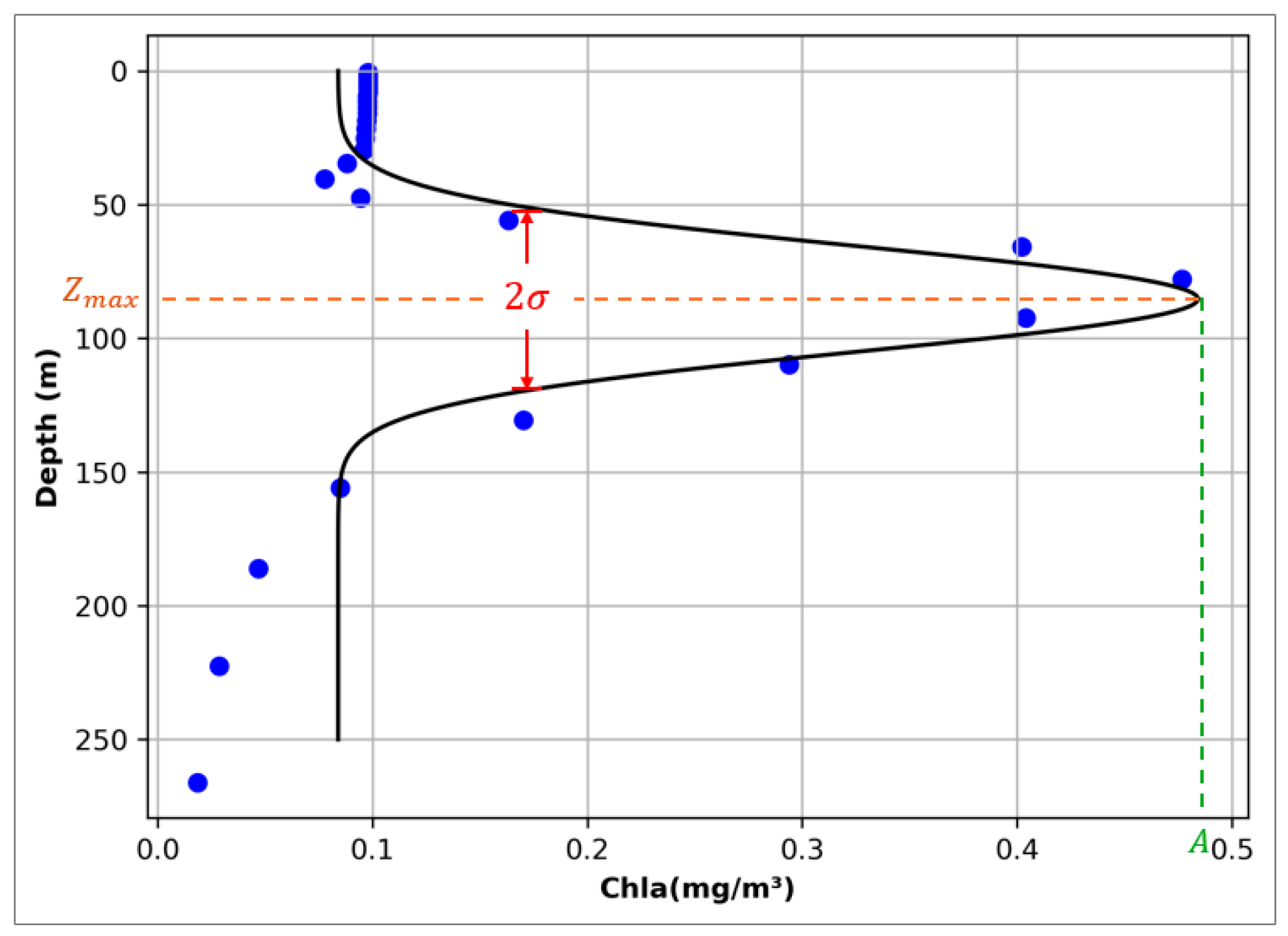
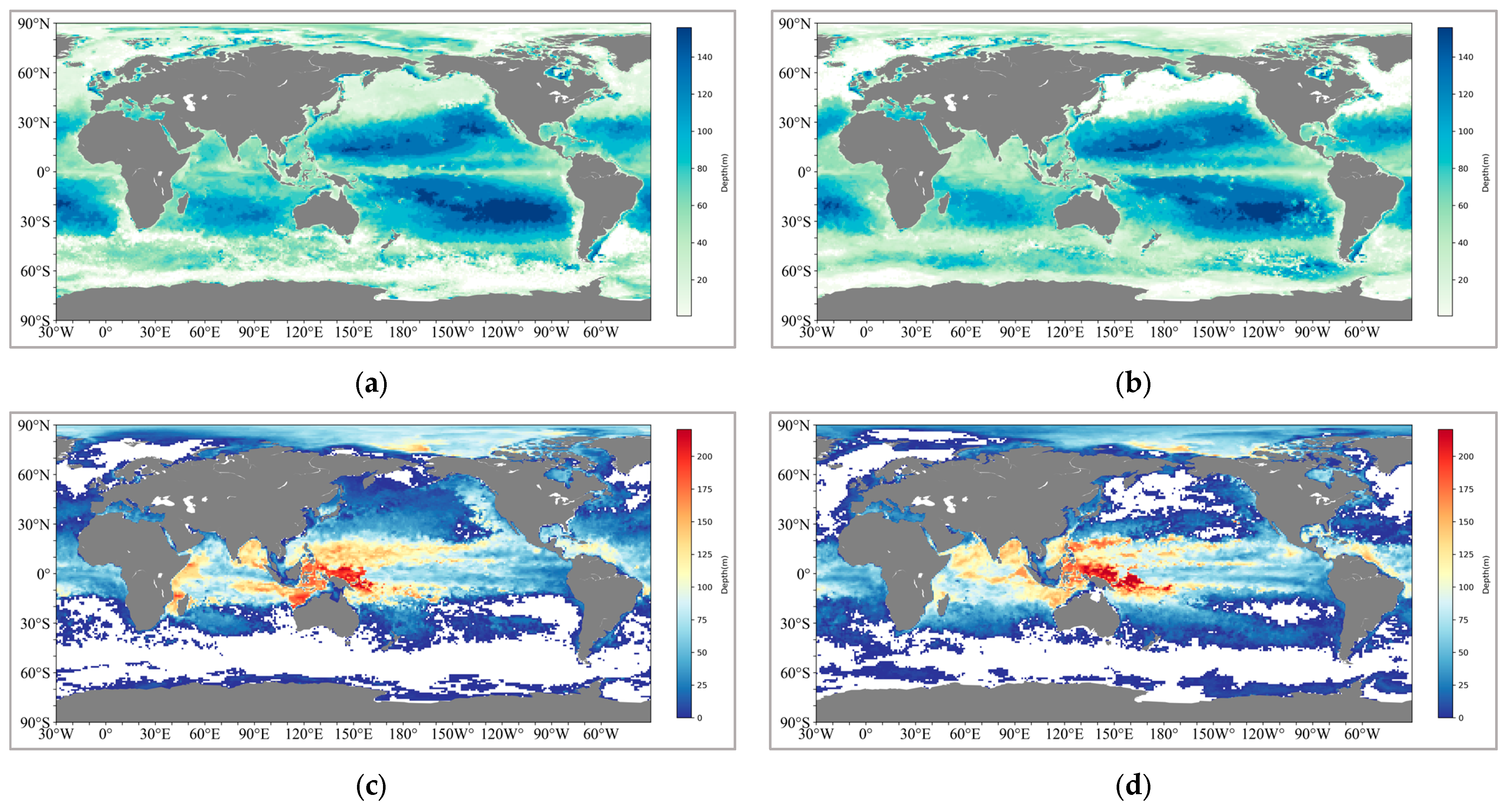

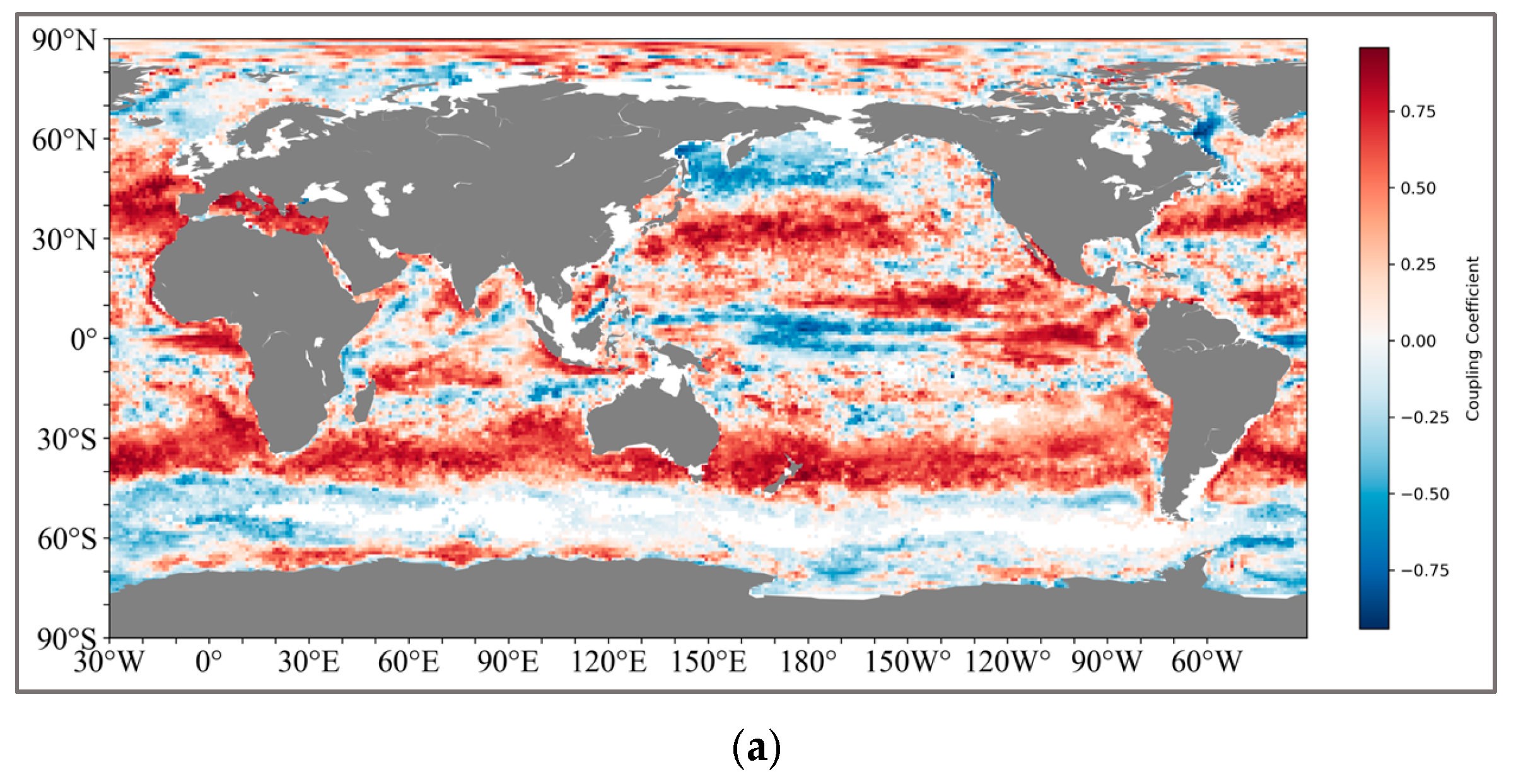





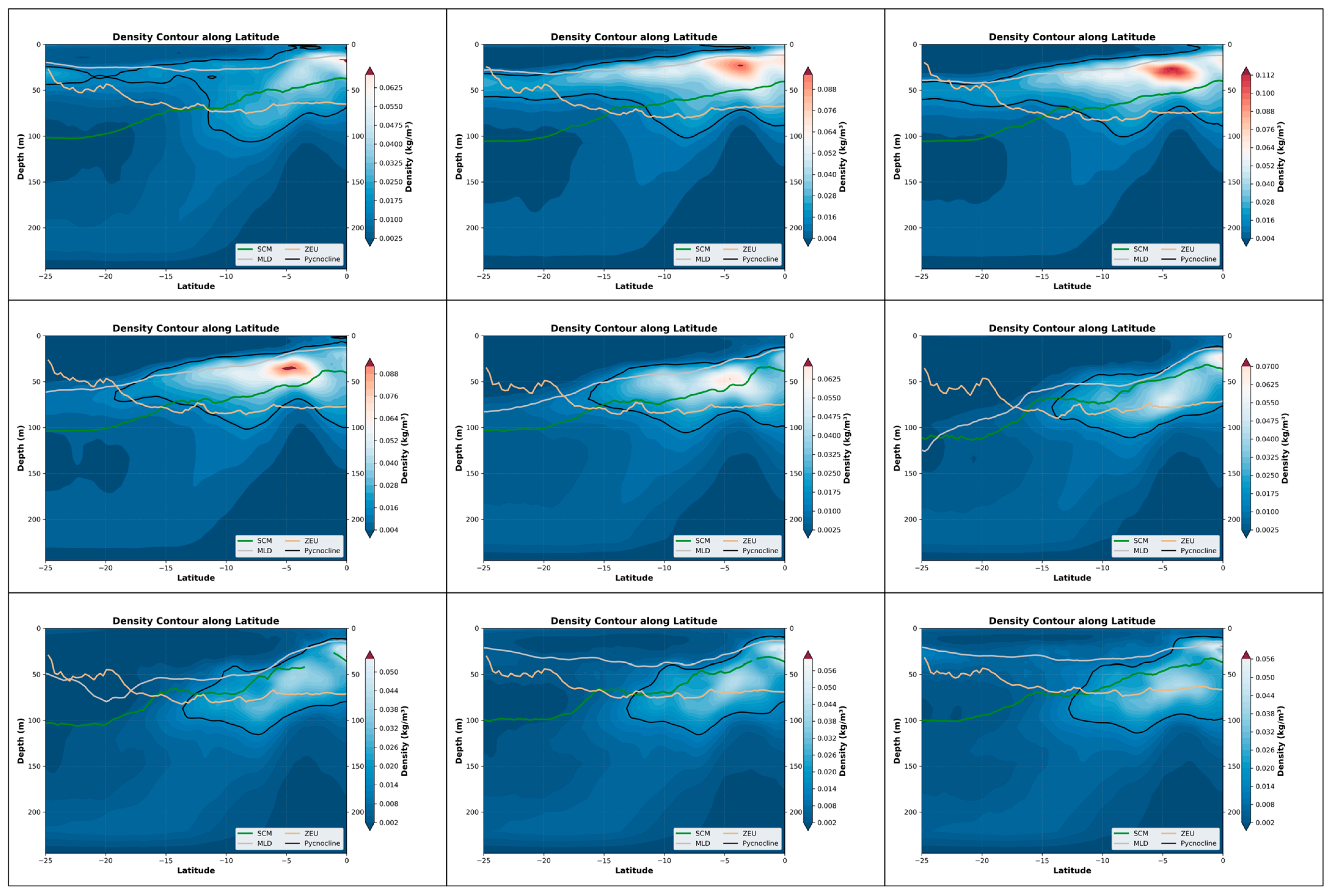

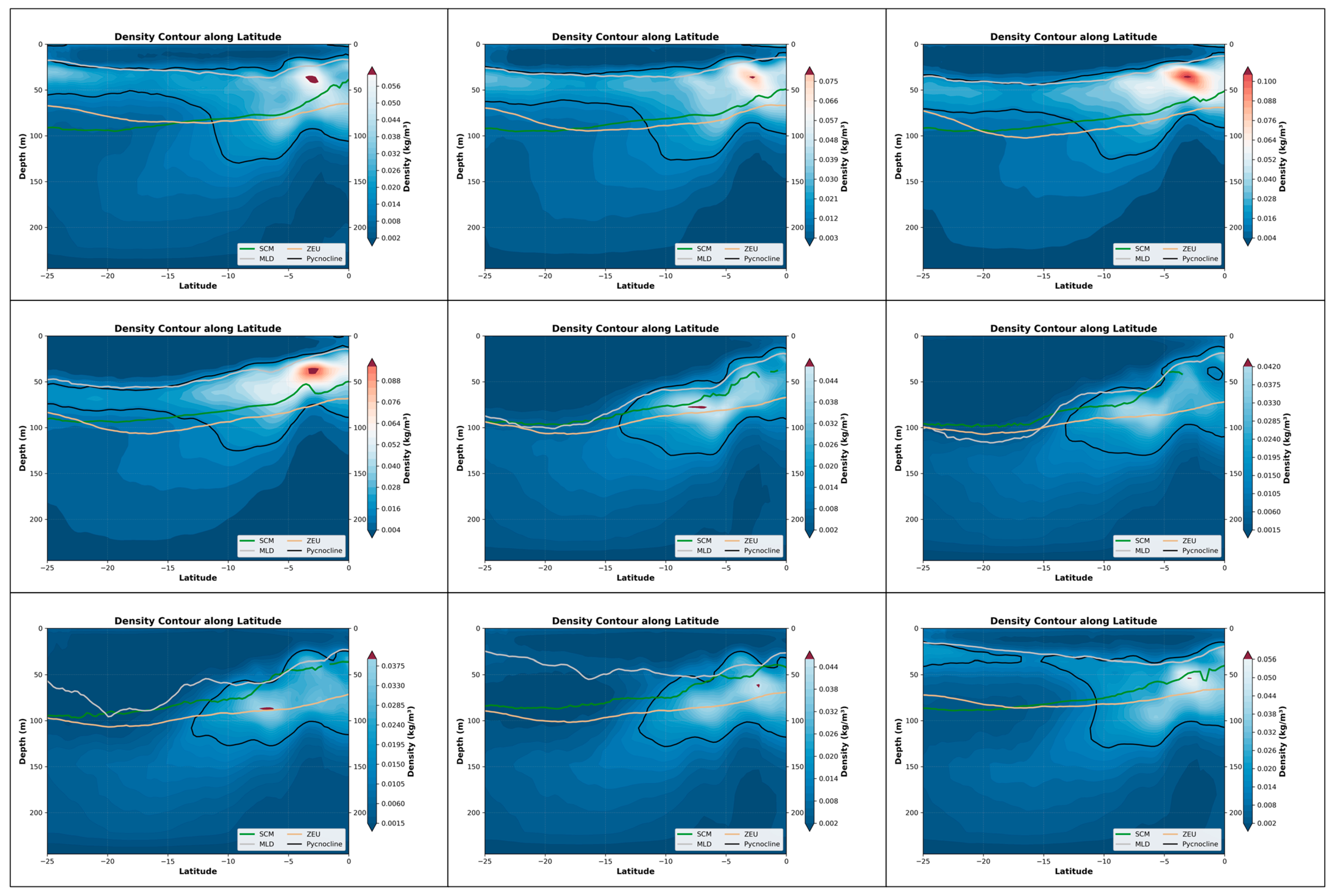

| Month | (Thickness) | (Intensity) | (Depth) | |
|---|---|---|---|---|
| 1 | 0.672 | 0.147 | −0.085 | 0.499 |
| 2 | 0.604 | 0.24 | −0.011 | 0.544 |
| 3 | 0.66 | 0.18 | 0.019 | 0.587 |
| 4 | 0.698 | 0.148 | 0.076 | 0.678 |
| 5 | 0.632 | 0.123 | 0.075 | 0.557 |
| 6 | 0.612 | 0.073 | 0.041 | 0.452 |
| 7 | 0.548 | 0.026 | 0.009 | 0.316 |
| 8 | 0.465 | −0.006 | 0.043 | 0.243 |
| 9 | 0.375 | −0.003 | 0.189 | 0.258 |
| 10 | 0.334 | −0.043 | 0.362 | 0.372 |
| 11 | 0.408 | −0.071 | 0.383 | 0.478 |
| 12 | 0.609 | −0.075 | 0.163 | 0.485 |
| Month | (Thickness) | (Intensity) | (Depth) | |
|---|---|---|---|---|
| 1 | 0.355 | 0.274 | 0.227 | 0.567 |
| 2 | 0.253 | 0.205 | 0.42 | 0.573 |
| 3 | 0.242 | 0.175 | 0.429 | 0.445 |
| 4 | 0.239 | 0.233 | 0.32 | 0.327 |
| 5 | 0.286 | 0.196 | 0.199 | 0.228 |
| 6 | 0.409 | 0.178 | 0.033 | 0.228 |
| 7 | 0.145 | −0.008 | 0.43 | 0.238 |
| 8 | 0.029 | −0.222 | 0.441 | 0.317 |
| 9 | 0.075 | −0.245 | 0.321 | 0.222 |
| 10 | 0.354 | −0.123 | −0.149 | 0.125 |
| 11 | 0.393 | 0.123 | −0.193 | 0.216 |
| 12 | 0.474 | 0.293 | −0.116 | 0.436 |
| Month | (Thickness) | (Intensity) | (Depth) | |
|---|---|---|---|---|
| 1 | −0.124 | −0.29 | 0.083 | 0.117 |
| 2 | −0.323 | −0.487 | −0.135 | 0.403 |
| 3 | −0.358 | −0.481 | 0.007 | 0.446 |
| 4 | −0.329 | −0.478 | 0.037 | 0.443 |
| 5 | −0.166 | −0.219 | 0.276 | 0.163 |
| 6 | −0.245 | −0.413 | −0.002 | 0.329 |
| 7 | −0.113 | −0.365 | 0.082 | 0.162 |
| 8 | −0.074 | −0.316 | 0.159 | 0.099 |
| 9 | −0.174 | −0.277 | 0.137 | 0.114 |
| 10 | −0.19 | −0.28 | 0.104 | 0.131 |
| 11 | −0.293 | −0.319 | 0.011 | 0.26 |
| 12 | −0.367 | −0.393 | −0.05 | 0.434 |
| Month | (Thickness) | (Intensity) | (Depth) | |
|---|---|---|---|---|
| 1 | 0.216 | −0.075 | 0.229 | 0.149 |
| 2 | 0.232 | −0.03 | 0.394 | 0.323 |
| 3 | 0.06 | −0.028 | 0.646 | 0.471 |
| 4 | 0.008 | −0.034 | 0.837 | 0.704 |
| 5 | 0.012 | −0.077 | 0.853 | 0.728 |
| 6 | −0.023 | −0.216 | 0.637 | 0.349 |
| 7 | 0.054 | −0.295 | 0.328 | 0.112 |
| 8 | 0.006 | −0.241 | 0.35 | 0.096 |
| 9 | 0.038 | −0.184 | 0.297 | 0.07 |
| 10 | 0.044 | −0.164 | 0.266 | 0.057 |
| 11 | 0.141 | −0.081 | 0.179 | 0.067 |
| 12 | 0.155 | −0.037 | 0.276 | 0.14 |
Disclaimer/Publisher’s Note: The statements, opinions and data contained in all publications are solely those of the individual author(s) and contributor(s) and not of MDPI and/or the editor(s). MDPI and/or the editor(s) disclaim responsibility for any injury to people or property resulting from any ideas, methods, instructions or products referred to in the content. |
© 2025 by the authors. Licensee MDPI, Basel, Switzerland. This article is an open access article distributed under the terms and conditions of the Creative Commons Attribution (CC BY) license (https://creativecommons.org/licenses/by/4.0/).
Share and Cite
Yang, J.; Han, Y.; Hou, M.; Fang, L. Variation in SCM Supply Effects as Reflected by Coupling Relationship with Pycnocline. Remote Sens. 2025, 17, 3283. https://doi.org/10.3390/rs17193283
Yang J, Han Y, Hou M, Fang L. Variation in SCM Supply Effects as Reflected by Coupling Relationship with Pycnocline. Remote Sensing. 2025; 17(19):3283. https://doi.org/10.3390/rs17193283
Chicago/Turabian StyleYang, Jie, Yunzhao Han, Meng Hou, and Lixing Fang. 2025. "Variation in SCM Supply Effects as Reflected by Coupling Relationship with Pycnocline" Remote Sensing 17, no. 19: 3283. https://doi.org/10.3390/rs17193283
APA StyleYang, J., Han, Y., Hou, M., & Fang, L. (2025). Variation in SCM Supply Effects as Reflected by Coupling Relationship with Pycnocline. Remote Sensing, 17(19), 3283. https://doi.org/10.3390/rs17193283





